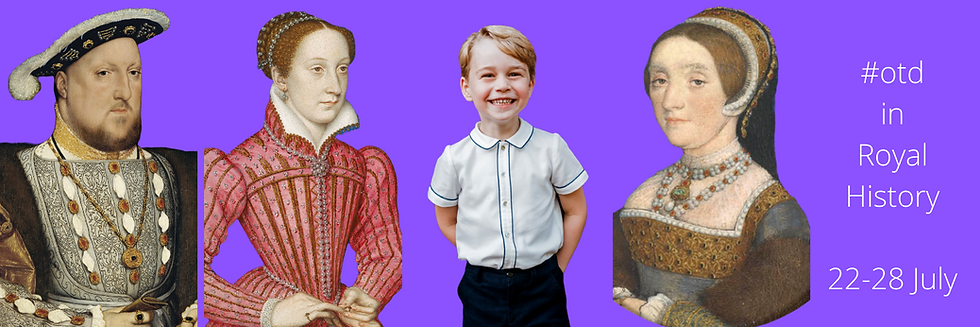
22 July
22 July 1210 - Joan of England, Queen of Scotland was born.

Joan of England, was Queen consort of Scotland from 1221 until her death. She was the third child of John, King of England & Isabella of Angoulême.
On 21 June 1221, Joan married Alexander II, King of Scotland on 21 June 1221 at York Minster. Alexander was twenty-three. Joan was almost eleven. They had no children. This fact was a matter of concern, but an annulment of the marriage was regarded as risky as it could provoke war with England. Queen Joan did not have a strong position at the Scottish court, which was dominated by her mother-in-law, queen dowager Ermengarde. Her English connections nevertheless made her important regardless of her personal qualities. Joan accompanied Alexander to England in September 1236 at Newcastle, & in September 1237 at York, during the negotiations with her brother King Henry III over disputed northern territories. At this point, chronicler Matthew Paris suggests that Joan & Alexander had become estranged & that Joan wished to spend more time in England, & her brother King Henry granted her manors in Driffield, Yorkshire & Fen Stanton in Huntingdonshire to reside if needed. In York, Joan & her sister-in-law Eleanor of Provence agreed to make a pilgrimage to Thomas Becket's shrine in Canterbury. Joan died in the arms of her brothers King Henry & Richard of Cornwall at Havering-atte-Bower in 1238, & was buried at Tarrant Crawford Abbey in Dorset in accordance with her wishes.
22 July 1298 – Wars of Scottish Independence: Battle of Falkirk: King Edward I of England & his longbowmen defeat William Wallace & his Scottish schiltrons outside the town of Falkirk.


22 July 1315 - Siege of Carlisle begins.
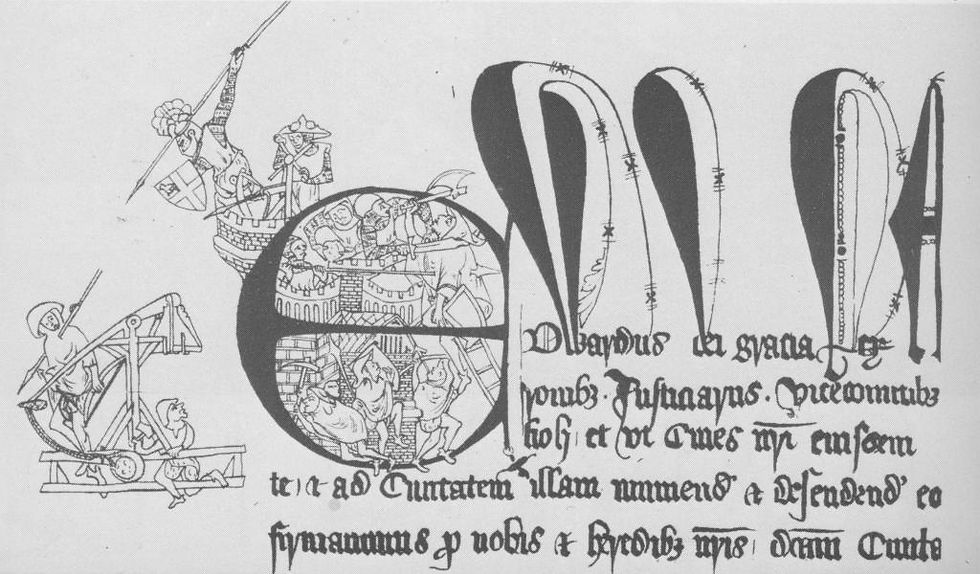
Detail from Royal charter awarded to Carlisle; Andrew Harclay throwing spears at the soldiers below
The Siege of Carlisle took place from 22 July to 1 August 1315, during the First War of Scottish Independence, near the town of Carlisle, in Cumbria, England. Following victory at Bannockburn in 1314, Robert the Bruce, King of Scotland, launched a series of raids into Northern England. Many areas along the Anglo-Scottish border were claimed by both Scotland & England, including Carlisle, which controlled access to North-West England. Carlisle Castle was a strong position, defended by a garrison commanded by Andrew Harclay, 1st Earl of Carlisle, an experienced veteran soldier. Despite their battlefield victories, the Scots lacked the expertise or resources necessary to sustain a lengthy siege; after failing to breach the walls, they withdrew on 1 August. Victory played an important part in Harclay's rise to prominence; he was later created Earl of Carlisle, before being executed in 1323.

Visit Carlisle Castle: Standing proud in the city it has dominated for nine centuries, Carlisle Castle remained a working fortress until well within living memory. It has withstood many sieges, held captive a royal prisoner, & been home to the King's Own Royal Border Regiment. Explore the medieval castle rooms, discover a turbulent history with the exhibition, & walk some of the castle walls. We're also home to Cumbria's Museum of Military Life.
22 July 1706 – The Acts of Union 1707 are agreed upon by commissioners from the Kingdom of England & the Kingdom of Scotland, which, when passed by each countries' Parliaments, led to the creation of the Kingdom of Great Britain.
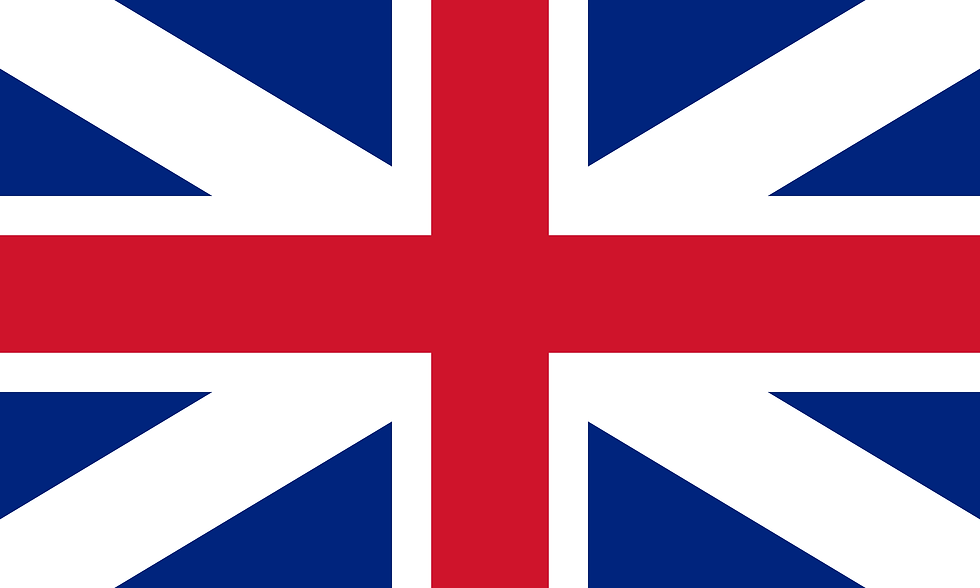
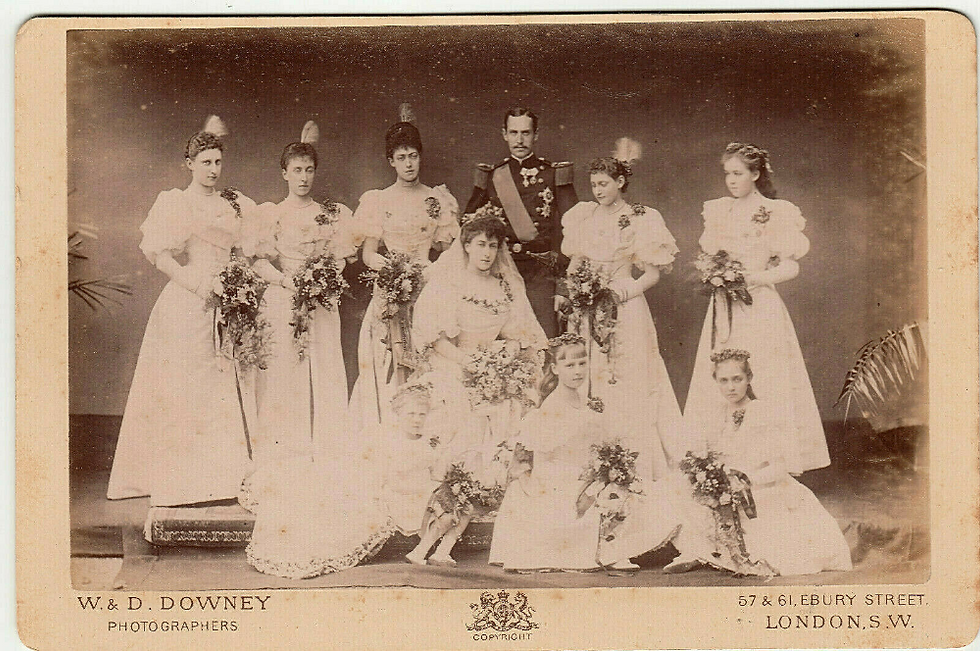
22 July 1896 - Princess Maud of wales married Prince Carl of Denmark
Maud of Wales (26 November 1869 – 20 November 1938) was the youngest daughter of King Edward VII & Queen Alexandra of the United Kingdom.
Haakon VII (Born Prince Carl of Denmark; 3 August 1872 – 21 September 1957) was the King of Norway from November 1905 until his death in September 1957. Originally a Danish prince, he was born in Copenhagen as the son of the future Frederick VIII of Denmark & Louise of Sweden.
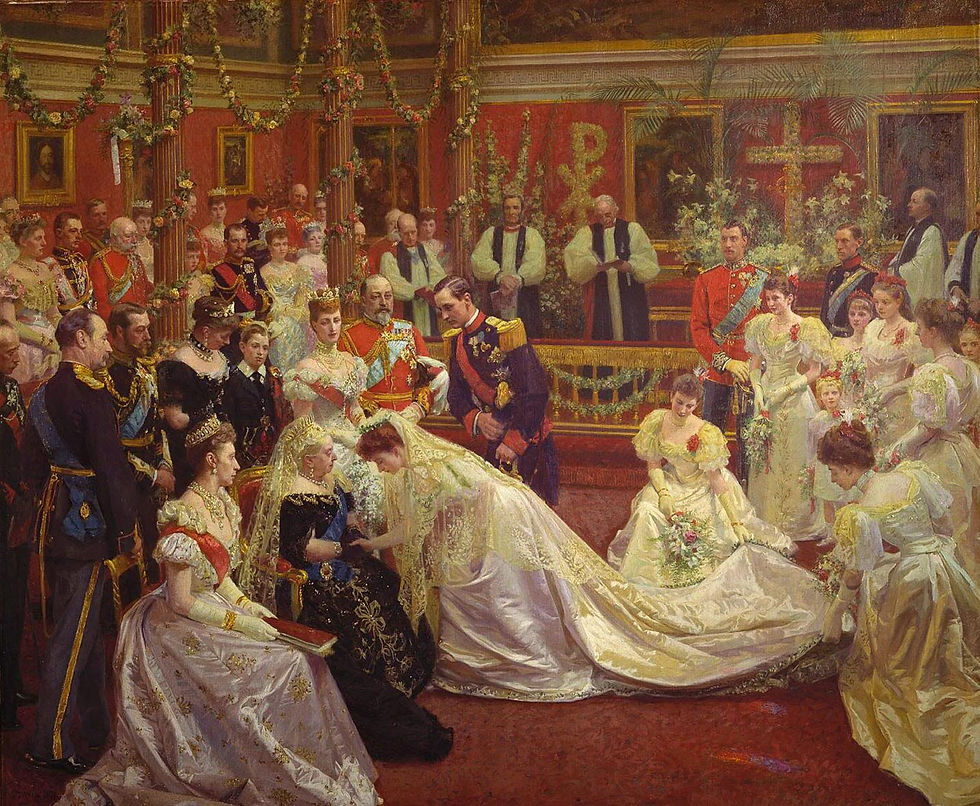
The Marriage of Princess Maud of Wales & Prince Carl of Denmark by Laurits Tuxen
On 22 July 1896, Princess Maud married her first cousin, Prince Carl of Denmark, in the private chapel at Buckingham Palace. The bride's father gave them Appleton House on the Sandringham Estate as a country residence for her frequent visits to England. It was there that the couple's only child, Prince Alexander (later Olav V, king of Norway), was born on 2 July 1903 in Sandringham.
Prince Carl served as an officer in the Royal Danish Navy, & he & his family lived mainly in Denmark until 1905. In June 1905 the Norwegian Storting dissolved Norway's 91-year-old union with Sweden & voted to offer the throne to Prince Carl of Denmark. Maud's membership in the British royal house played some part in why Carl was chosen. Following a plebiscite in November, Prince Carl accepted the Norwegian throne as King Haakon VII, while his young son was renamed Olav. King Haakon VII & Queen Maud were crowned at Nidaros Cathedral in Trondheim on 22 June 1906.
22 July 2013 - Prince George of Cambridge was born
Prince George of Cambridge (George Alexander Louis; born 22 July 2013) is the eldest child of Prince William, Duke of Cambridge, & Catherine, Duchess of Cambridge, & third in the line of succession to the British throne behind his grandfather Prince Charles & his father. As he is expected to become king one day, his birth was widely celebrated across the Commonwealth realms. George occasionally accompanies his parents on royal tours & engagements.
23 July
23 July 1536 – Henry FitzRoy, 1st Duke of Richmond & Somerset, English politician, Lord Lieutenant of Ireland died.

23 July 1885 - Princess Beatrice married Prince Henry of Battenberg.

Princess Beatrice in her wedding dress, Osborne, 1885. Beatrice wore her mother's wedding veil of Honiton lace.
Princess Beatrice fell in love with Prince Henry of Battenberg, the son of Prince Alexander of Hesse and by Rhine & Julia von Hauke & brother-in-law of her niece Princess Victoria of Hesse and by Rhine. After a year of persuasion, the Queen, whose consent was required pursuant to the Royal Marriages Act, finally agreed to the marriage, which took place at Whippingham on the Isle of Wight on 23 July 1885. Queen Victoria consented on condition that Beatrice & Henry make their home with her & that Beatrice continue her duties as the Queen's unofficial secretary. The Prince & Princess had four children, but 10 years into their marriage, on 20 January 1896, Prince Henry died of malaria while fighting in the Anglo-Asante War. Beatrice remained at her mother's side until Queen Victoria died on 22 January 1901.

Their four children were;
Alexander Mountbatten, Marquess of Carisbrooke (1886 - 1960).
Victoria Eugénie, later Queen of Spain (1887 - 1969). She married Alfonso XIII of Spain (1886 – 1941) in 1906.
Lord Leopold Mountbatten (1889 - 1922). Suffered from haemophilia, & during a knee operation.
Prince Maurice of Battenberg (1891 - 1914). Died of wounds from action during World War I.
24 July

24 July 759 – Oswulf, king of Northumbria died
Oswulf was king of Northumbria from 758 to 759. He succeeded his father Eadberht, who had abdicated & joined the monastery at York. Oswulf's uncle was Ecgbert, Archbishop of York. In spite of his father's long reign, & his powerful uncle, Oswulf did not hold the throne for long. He was murdered within a year of coming to power, by members of his household, by his servants or bodyguards, at Market Weighton, on 24 July 759. The death of Oswulf's brother, Oswine, is recorded at "Eldunum near Mailros" in August 761, in battle against Æthelwald Moll, who had seized the throne on Oswulf's death.
24 July 1304 – Wars of Scottish Independence: Fall of Stirling Castle: King Edward I of England takes the stronghold using the War Wolf.

24 July 1567 – Mary, Queen of Scots, is forced to abdicate & replaced by her 1-year-old son James VI.




24 July 1689 - Prince William, Duke of Gloucester was born



25 July
Possibly 25 July 1394 – James I, king of Scotland was born.

James I (late July 1394 – 21 February 1437) was King of Scots from 1406 to 1437. He was the youngest of three sons, he was born in Dunfermline Abbey to King Robert III & his wife Annabella Drummond. His older brother David, Duke of Rothesay, died under suspicious circumstances while being detained by their uncle, Robert, Duke of Albany. His other brother, Robert, died young. Fears for James's safety grew through the winter of 1405/6 & plans were made to send him to France. In February 1406, James was forced to take refuge in the castle of the Bass Rock in the Firth of Forth after his escort was attacked by supporters of Archibald, 4th Earl of Douglas. He remained there until mid-March when he boarded a vessel bound for France. On 22 March English pirates captured the ship & delivered the prince to Henry IV of England. The ailing Robert III died on 4 April & the 11-year-old James, now the uncrowned King of Scotland, would not regain his freedom for another eighteen years.
James was educated well at the English Court where he developed respect for English methods of governance & for Henry V. His cousin, Murdoch Stewart, Albany's son, who had been an English prisoner since 1402, was traded for Henry Percy, 2nd Earl of Northumberland, in 1416. James had married Joan Beaufort, daughter of the Earl of Somerset, in February 1424 just before his release in April. The King's re-entry into Scottish affairs was not altogether popular since he had fought on behalf of Henry V in France & at times against Scottish forces.
25 July 1554 – Mary I of England marries Philip II of Spain at Winchester Cathedral.



25 July 1603 – James VI of Scotland is crowned king of England (James I of England), bringing the Kingdom of England & Kingdom of Scotland into personal union. Political union would occur in 1707.




26 July
26 July 1450 – Cecily Neville, duchess of Warwick died.

Cecily Neville (3 May 1415 – 31 May 1495) was an English noblewoman, the wife of Richard, Duke of York (1411–1460), & the mother of two kings of England, Edward IV & Richard III. Cecily was known as "the Rose of Raby", because she was born at Raby Castle in Durham, & "Proud Cis", because of her pride & a temper that went with it, although she was also known for her piety. She herself signed her name "Cecylle". Her husband, the Duke of York, was the leading contender for the throne of England from the House of York during the period of the War of the Roses until his death in 1460. Their son Edward actually assumed the throne as Edward IV in 1461, after the deposition of King Henry VI of the House of Lancaster. The Duchess of York thus narrowly missed becoming queen consort of England.
She married Richard, 3rd Duke of York, before 1430. They had twelve children;
Anne of York (1439 – 1476)
Henry of York (1441 – 1441), died soon after birth.
Edward IV of England (1442 – 1483).
Edmund, Earl of Rutland (1443 – 1460).
Elizabeth of York (1444 – possibly after 1503), wife of John de la Pole, 2nd Duke of Suffolk.
Margaret of York (1446 – 1503), married Charles I, Duke of Burgundy.
William of York (1447 – died young).
John of York (1448 – died young).
George Plantagenet, 1st Duke of Clarence (1449 – 1478), executed by his brother Edward IV.
Thomas of York (1450/1451 – died young).
Richard III of England (2 October 1452 - 1485), killed in battle at the Battle of Bosworth Field.
Ursula of York (1455 – died young).
26 July 1469 – Wars of the Roses: The Battle of Edgcote Moor, pitting the forces of Richard Neville, 16th Earl of Warwick against those of Edward IV of England, takes place.


26 July 1944 - General Leese received his knighthood in the field from King George VI.

Lieutenant-General Sir Oliver William Hargreaves Leese, 3rd Baronet, KCB, CBE, DSO (27 October 1894 – 22 January 1978) was a senior British Army officer who saw distinguished active service during both the world wars. He is most notable during the Second World War for commanding XXX Corps in North Africa & Sicily, serving under General Sir Bernard Montgomery, before going on to command the Eighth Army in the Italian Campaign throughout most of 1944.
27 July
27 July 1054 – Siward, Earl of Northumbria, invades Scotland & defeats Macbeth, King of Scotland somewhere north of the Firth of Forth.
27 July 1158 – Geoffrey VI, Count of Anjou died (b. 1134)
Geoffrey VI (1 June 1134 – 27 July 1158) was Count of Nantes from 1156 to 1158. He was also known as Geoffrey of Anjou & Geoffrey FitzEmpress. He was the son of Geoffrey Plantagenet & Empress Matilda. His brothers were Henry II of England & William FitzEmpress.
27 July 1214 - Battle of Bouvines




27 July 1380 - Henry of Bolingbroke (later Henry IV) married Mary de Bohun.
The date & venue of Henry's first marriage to Mary de Bohun (died 1394) are uncertain but her marriage licence, purchased by Henry's father John of Gaunt in June 1380, is preserved at the National Archives. The accepted date of the ceremony is 5 February 1381, at Mary's family home of Rochford Hall, Essex. They had six children including the future Henry V of England (1386–1422).

Henry IV (April 1367 – 20 March 1413) was King of England from 1399 to 1413. He was the son of John of Gaunt, Duke of Lancaster, & his first wife Blanche. Mary de Bohun (c. 1369/70 – 4 June 1394) was a daughter of Humphrey de Bohun, 7th Earl of Hereford by his wife Joan FitzAlan. Mary died at Peterborough Castle, giving birth to her last child, a daughter, Philippa of England. Henry later married Joanna, the daughter of Charles II of Navarre, at Winchester in 1403.
Did you know? Henry was the first English ruler since the Norman Conquest, over three hundred years prior, whose mother tongue was English rather than French.
27 July 1689 – Glorious Revolution: The Battle of Killiecrankie is a victory for the Jacobites.



27 July 1850 - Queen Victoria was attacked by former soldier Robert Pate
The Queen was visiting Cambridge House in Piccadilly on 27 June 1850, in order to see her dying uncle, Prince Adolphus, Duke of Cambridge.
At about 6:20 that evening, her carriage was leaving the courtyard when Robert Pate hit her on the head with the short cane with brass ferule that he was carrying. The blow was heavy enough to crush her bonnet & draw a little blood. The attack was the only one of several attempts that caused Victoria actual harm & the mark on her forehead remained for a decade. The Queen’s appearance within two hours at Covent Garden proved not that she hadn’t been greatly injured, but that she bravely refused to let her injury prevent her from going among her subjects.

Pate was immediately arrested & was quickly put on trial. His defence team did not plead insanity, but instead asked for a lenient sentence on the grounds of a momentary lapse caused by a weak mind. Pate was sentenced to seven years of penal transportation to Van Diemen's Land (now known as Tasmania), which his father thought a better result than the ignominy of imprisonment in the UK accompanied by a birching, even though that was a nominally lesser sentence. Nearly half a century later, on New Year’s Day 1899, Lloyd’s Weekly Newspaper reported in an article entitled “Notoriety of a Stick” that what was apparently Pate’s weapon was to be sold at auction in London. A quiet word was sent from Osborne, where the Queen was in residence, to the auction house. The cane was withdrawn from sale. It has never come before the public since.

27 July 1889 - Princess Louise married Alexander Duff, Earl of Fife
Photograph of the Duke of Fife & Princess Louise with bridesmaids: Left to right, standing: Princess Victoria of Wales; the Duke of Fife; Princess Louise; Princess May of Teck (later Queen Mary); Princess Marie Louise of Schleswig-Holstein; Countess Feodore Gleichen. Seated: Princess Maud of Wales; Countess Helena Gleichen; Countess Victoria Gleichen; Princess Helena Victoria of Schleswig-Holstein.
On Saturday 27 July 1889, Princess Louise (later the Princess Royal) married the 6th Earl Fife, at the Private Chapel in Buckingham Palace. He was eighteen years her senior, but her third cousin in descent from George III. Two days after the wedding, Queen Victoria created him Duke of Fife & Marquess of Macduff in the Peerage of the United Kingdom. The Letters Patent creating this dukedom contained the standard remainder to "male heirs of the body lawfully begotten." However, it eventually became apparent that the Duke & Duchess would not have a son. Therefore, on 24 April 1900, Queen Victoria signed Letters Patent creating a second Dukedom of Fife, along with the Earldom of Macduff in the Peerage of the United Kingdom with a special remainder: in default of a male heir, these peerages would pass to the daughters of the 1st Duke & then to their male descendants.
Louise, Princess Royal & Duchess of Fife (20 February 1867 – 4 January 1931) was the third child & eldest daughter of King Edward VII & Queen Alexandra of the United Kingdom; she was a younger sister of King George V. Louise was given the title of Princess Royal in 1905. Alexander William George Duff, 1st Duke of Fife (10 November 1849 – 29 January 1912) styled Viscount Macduff between 1857 & 1879 & known as The Earl Fife between 1879 & 1889, was a Scottish peer.
The Duke & Duchess of Fife had three children:
Alastair Duff, Marquess of Macduff, (stillborn 16 June 1890)
Princess Alexandra, 2nd Duchess of Fife; (17 May 1891 – 26 February 1959)
Princess Maud of Fife; (3 April 1893 – 14 December 1945)
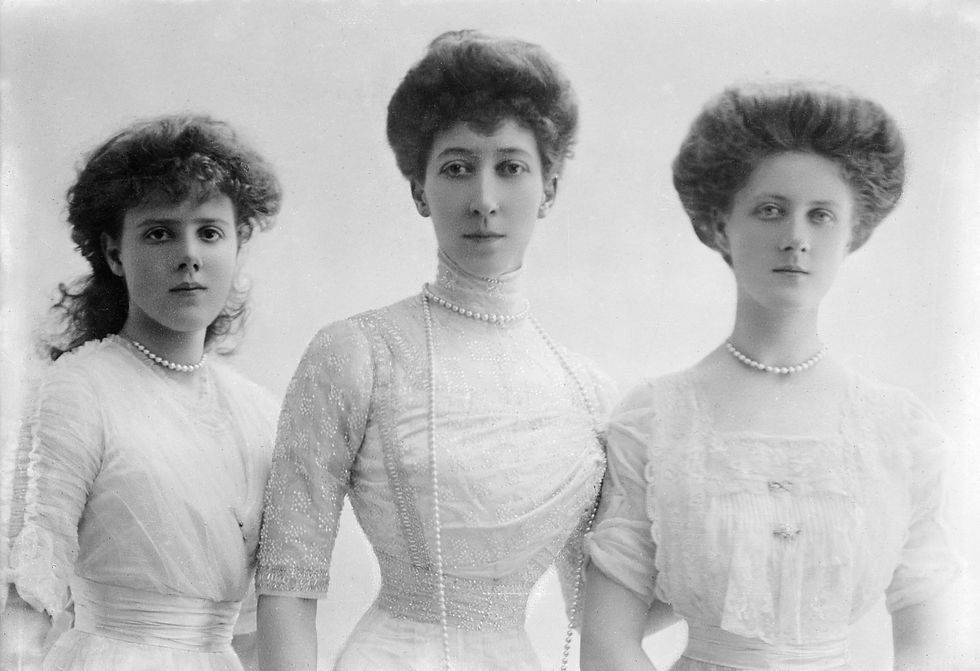
Louise, Princess Royal & Duchess of Fife with her daughters Princess Maud of Fife & Princess Alexandra of Fife, ca 1911.
28 July
28 July 1540 – Thomas Cromwell is executed at the order of Henry VIII of England on charges of treason. Henry marries his fifth wife, Catherine Howard, on the same day.

Thomas Cromwell (c. 1485 – 28 July 1540) was an English lawyer & leading statesman who served as chief minister to King Henry VIII from 1534 to 1540, when he was beheaded on orders of the king.
Cromwell was one of the strongest & most powerful proponents of the English Reformation. He helped to engineer an annulment of the king's marriage to Katharine of Aragon so that Henry could lawfully marry Anne Boleyn. Henry failed to obtain the Pope's approval for the annulment in 1534, so Parliament endorsed the king's claim to be Supreme Head of the Church of England, giving him the authority to annul his own marriage. During his rise to power, Cromwell made many enemies, including his former ally Anne Boleyn. He played a prominent role in her downfall. He later fell from power, after arranging the king's marriage to German princess Anne of Cleves. Cromwell had hoped that the marriage would breathe fresh life into the Reformation in England, but Henry found his new bride unattractive & it turned into a disaster for Cromwell, ending in an annulment six months later. The unfortunate Cromwell was arraigned under a bill of attainder & executed for treason & heresy on Tower Hill on 28 July 1540. The king later expressed regret at the loss of his chief minister.
28 July 1540 - King Henry VIII marries Catherine Howard, his fifth wife.

Portrait Miniature of Katherine Howard, c. 1540 (Buccleuch Collection)
On the same day Cromwell was executed, the 49 year old Henry married the young Catherine Howard (c. 1523 – 13 February 1542) , a first cousin & lady-in-waiting of Anne Boleyn at Oatlands Palace. Henry was delighted with his new queen & awarded her the lands of Cromwell & a vast array of jewellery.

Soon after the marriage, however, Queen Catherine had an affair with the courtier Thomas Culpeper. She also employed Francis Dereham, who had previously been informally engaged to her & had an affair with her prior to her marriage, as her secretary. The Privy Council was informed of her affair with Dereham whilst Henry was away; Thomas Cranmer was dispatched to investigate, & he brought evidence of Queen Catherine's previous affair with Dereham to the king's notice. Henry originally refused to believe the allegations, but Dereham confessed. It took another meeting of the council, before Henry believed the accusations against Dereham & went into a rage, blaming the council before consoling himself in hunting. When questioned, the queen could have admitted a prior contract to marry Dereham, which would have made her subsequent marriage to Henry invalid, but she instead claimed that Dereham had forced her to enter into an adulterous relationship. Dereham, meanwhile, exposed Catherine's relationship with Culpeper. Culpeper & Dereham were both executed, & Catherine too was beheaded on 13 February 1542.
Thank you for reading.


Kaiser OTC benefits provide members with discounts on over-the-counter medications, vitamins, and health essentials, promoting better health management and cost-effective wellness solutions.
Obituaries near me help you find recent death notices, providing information about funeral services, memorials, and tributes for loved ones in your area.
is traveluro legit? Many users have had mixed experiences with the platform, so it's important to read reviews and verify deals before booking.